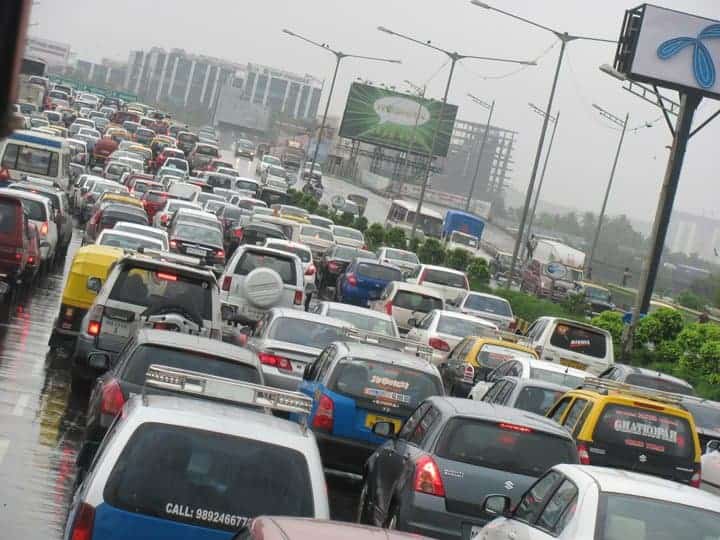My friend Arun, spends 20-30 minutes everyday, waiting in his car at the toll plaza to exit Mumbai so that he can reach his office in Thane. Like him, there are lakhs of vehicles that exit and enter the island city of Mumbai daily. I used to as well, but not since I switched jobs.
Blessed with a seafront on most of its periphery, there are only 5 entry/ exit points for vehicular traffic in Mumbai:
- Dahisar (Western Express Highway)
- Vashi (Sion-Panvel Highway)
- Mulund East (Eastern Express Highway)
- Airoli (Mulund-Airoli Bridge)
- Mulund West (LBS Marg).
Data compiled by Mumbai Vikas Samiti in Dec 2018 indicated that 6 lakh vehicles were entering Mumbai daily on weekdays, via these 5 entry points. The huge figure is not surprising, considering that people work all across the Mumbai Metropolitan Region (MMR) commuting several kilometres everyday between their homes and work places.
Today, given that the data is over two years old, and the fact that Covid has brought about the need for social distancing, the number of vehicles is likely to be higher.
[MMR is spread over 6,640 sq km and consists of 9 Municipal Corporations viz. Greater Mumbai, Thane, Kalyan-Dombivali, Navi Mumbai, Ulhasnagar, Bhiwandi- Nizamapur, Vasai-Virar, Mira-Bhayandar and Panvel, 9 Municipal Councils viz. Ambarnath, Kulgaon-Badalapur, Matheran, Karjat, Khopoli, Pen, Uran, Alibaug and Palghar, along with more than 1,000 villages in Thane, Raigad and Palghar Districts.]

With toll collection booths at all 5 points, any vehicle that enters or leaves the city by road, will have to pay toll when travelling either way. There is no way that toll can be avoided. This process of payment of toll results in long queues (traffic jams), all throughout the day, and more so during the peak morning and evening hours.

Apart from the time spent at these toll booths (which drains our minds and bodies of all energy), there is the unnecessary burning of a huge amount of fuel on a daily basis, which drains our vehicles as well. In a bid to make the toll collection faster, FASTag has been introduced this year. Despite this, traffic jams at the toll plazas seem to be inevitable.
So what is the way around?
Read more: Using a FASTag to enter into Mumbai? Not so fast
A simple solution to improve operational efficiency at toll plazas
Currently a fixed toll is being collected for vehicles every time they enter or exit from Mumbai from any of the toll plazas. Instead of this current system, the proposal I have is to collect double toll from people entering Mumbai and no toll to those exiting Mumbai. It will be simple to implement, but let’s see the impact.
- As the toll will not be collected for vehicles leaving Mumbai, half the issue of traffic jams is solved. People from the non-Mumbai MMR areas going back home after a hard day will definitely like it. Those living in Mumbai and working out will save time while going to work.
- Infrastructure and manpower at the toll plaza will be reduced by half, so there will be super savings for the toll collecting agency which can improve efficiency of toll collection for vehicles entering Mumbai.
- At the exit points, there will be no need for any monitoring, checking, speed breakers, narrow toll lanes, etc. which will result in the seamless exit of vehicles.
- Reduction in the stationary traffic at the exit roads will reduce wear and tear of those lanes.
- Saving fuel and reduction in emission pollution would be additional, but very important benefits. The proposed solution will definitely help the environment.
- Vehicles like cabs which have different passengers while leaving the city and while entering can include the proportionate toll charges to their fare.
As vehicles entering will pay double toll, by and large, toll collection will not be much different from what it would be as per the current system. Vehicles that move to and fro on a daily basis will not affect toll collection. Those that come into Mumbai on an irregular basis will someday go out, and those that leave will someday return. If for some unknown reason the number of vehicles leaving Mumbai permanently goes up resulting in some nominal loss of toll, that would still be a small price to pay for decongesting the city and making the lives of road commuters a little more comfortable.
Also read:
Excellent idea Yogesh. Your earlier idea for decongestion at till plaza by having booths at different distance was also a good move. I fully support this simple yet effective solution
Detailed analysis. Perfect solution.
This seems to be a good suggestion to resolve a grave problem of travellers . The repercussions of the existing arrangements are already being faced by us.If implemented , then we may save a lot fuel, time and money which has been worthlessily draining for all these years. I hope this gets heard … keeping fingers crossed.